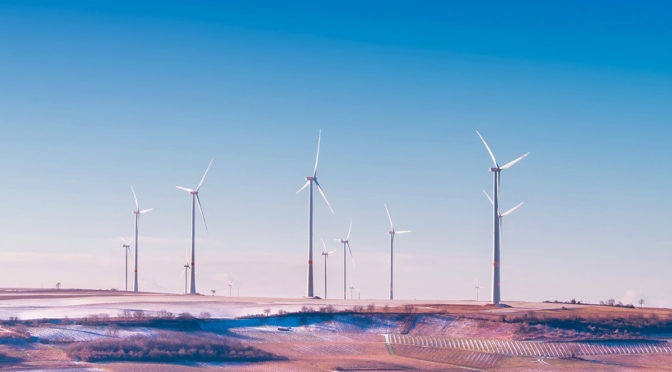On Tuesday 14 May On Tuesday 14 May WindEurope CEO Giles Dickson spoke on a panel on European energy markets at the European Economic Forum in Katowice, Poland.
Dickson told attendees that cross-border coupling of energy markets is not a future goal: it’s a present reality. There is already an integrated European market for energy – both in terms of ‘day-ahead’ and ‘intra-day’ energy. Europe already has cross-border PPAs (Google’s data centre in Finland buys its electricity from Swedish wind farms). The new offshore Poland-Lithuania interconnector, located by their respective offshore wind farms, will be commissioned in 2025 and will be 700 MW.
Now we are moving towards integrating the balancing market across borders.
But while this is all to be welcomed, Dickson warned that the current infrastructure to support cross-border energy markets is not good enough. It does not have enough capacity. We need to use it in a smarter way, closer to real time. Today, interconnectors are not being optimised. Dickson pointed to Poland as a clear example of this: Poland can occasionally be a bit of an “energy island” because of loop-flow blockages in its interconnectors with Germany and elsewhere. A solution to this is steady investment and planning. Grid development is not the only solution. Indeed, Dickson said, the regulatory framework should incentivise TSOs and DSOs to find alternative solutions to only building more grids and storage. Dickson told Polish delegates that they have to embrace the generation and trading of cheap low-carbon power before the blockages were removed. Failure to do so, he said, will ensure that Poland is flooded with cheap, low-carbon power from their neighbours in the near future.
The local impact of renewables is critical, Dickson said. He pointed to the fact that only 30 km from Katowice, the construction of a new wind farm is supporting 600 jobs in Silesia. This is just one of the wind farms being built from last year’s 1 GW auction. The next Polish auction, for 2.5 GW of onshore wind, is expected to take place later this year.
Discussing the outlook for renewables; Dickson noted that the Clean Energy Package means that not only renewables but also other technologies like demand-side response or storage should have equal opportunity to play the market. We have market-based mechanisms for renewables. Renewables are moving away from feed-in tariffs and are now “balancing responsible.” We have phased out priority dispatch, so we are more active in ensuring the reliability of the grid. However, despite the fact that our technology can provide ancillary services, the market for ancillary services needs to be better designed to allow for the participation of renewables. CEO Giles Dickson spoke on a panel on European energy markets at the European Economic Forum in Katowice, Poland.
Dickson told attendees that cross-border coupling of energy markets is not a future goal: it’s a present reality. There is already an integrated European market for energy – both in terms of ‘day-ahead’ and ‘intra-day’ energy. Europe already has cross-border PPAs (Google’s data centre in Finland buys its electricity from Swedish wind farms). The new offshore Poland-Lithuania interconnector, located by their respective offshore wind farms, will be commissioned in 2025 and will be 700 MW.
Now we are moving towards integrating the balancing market across borders.
But while this is all to be welcomed, Dickson warned that the current infrastructure to support cross-border energy markets is not good enough. It does not have enough capacity. We need to use it in a smarter way, closer to real time. Today, interconnectors are not being optimised. Dickson pointed to Poland as a clear example of this: Poland can occasionally be a bit of an “energy island” because of loop-flow blockages in its interconnectors with Germany and elsewhere. A solution to this is steady investment and planning. Grid development is not the only solution. Indeed, Dickson said, the regulatory framework should incentivise TSOs and DSOs to find alternative solutions to only building more grids and storage. Dickson told Polish delegates that they have to embrace the generation and trading of cheap low-carbon power before the blockages were removed. Failure to do so, he said, will ensure that Poland is flooded with cheap, low-carbon power from their neighbours in the near future.
The local impact of renewables is critical, Dickson said. He pointed to the fact that only 30 km from Katowice, the construction of a new wind farm is supporting 600 jobs in Silesia. This is just one of the wind farms being built from last year’s 1 GW auction. The next Polish auction, for 2.5 GW of onshore wind, is expected to take place later this year.
Discussing the outlook for renewables; Dickson noted that the Clean Energy Package means that not only renewables but also other technologies like demand-side response or storage should have equal opportunity to play the market. We have market-based mechanisms for renewables. Renewables are moving away from feed-in tariffs and are now “balancing responsible.” We have phased out priority dispatch, so we are more active in ensuring the reliability of the grid. However, despite the fact that our technology can provide ancillary services, the market for ancillary services needs to be better designed to allow for the participation of renewables.


